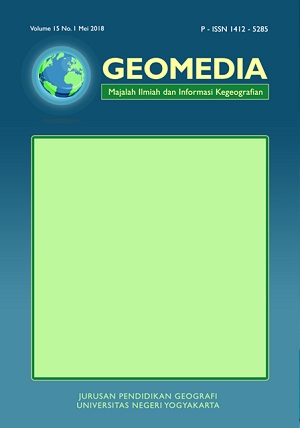Reciprocal-relationship between the development of "Trans Jogja" public transportation and urban spatial structure in Yogyakarta agglomeration
DOI:
https://doi.org/10.21831/gm.v22i1.72878Abstract
References
Ashari, A. (2017). Geomorphology of the Southern Flank of Merapi Volcano in Relation to the Potential Hazard and Natural Resources: A Review. Geomedia: Majalah Ilmiah Dan Informasi Kegeografian, 15(2), 183–192.
Ashari, A., & Purwantara, S. (2022). Bentanglahan Vulkanik Indonesia: Aspek Fisikal dan Kultural. UNY Press.
Chen, Z., Bai, Y., & Zhang, M. (2019). The spatial distribution of bus stations and optimization strategy in the main urban area of Lanzhou. 2019 4th International Symposium on Management, Economics, E-business and Marketing (ISMEEM 2019). Francis Academic Press.
Garcia-López, M. í ngel. (2012). Urban spatial structure, suburbanization and transportation in Barcelona. Journal of Urban Economics, 72(2–3), 176–190. https://doi.org/10.1016/j.jue.2012.05.003
Huang, Z., Wei, X., Shen, J., & Liu, X. (2009). Spatial Distribution of Bus Terminals in Large Cities "” The Case of Wuhan, China. Proceeding International Conference on Transportation Engineering.
Mohammadhasan, Y., Elham, S.F., & Ebrahim, F.M. (2019). Evaluation of Spatial Distribution Pattern of Urban Bus Stations and Evaluation of their Impacts on Utility of Public Transport Network Service of Ardabil City). Traffic Management Studies 54: 1-30.
Moran, M.E. (2022). Are shelters in place? Mapping the distribution of transit amenities via a bus-stop census of San Francisco. Journal of Public Transportation 24: 100023.
Purwantara, S., Ashari, A., & Ibrahim, M. H. Bin. (2020). The characteristics of infiltration on the southern flank of Merapi Volcanic Plain, Yogyakarta, Indonesia. International Journal of GEOMATE, 19(74), 201–209. https://doi.org/10.21660/2020.74.52941
Purwantara, S., Ashari, A., & Putro, S. T. J. (2021). The relationship between landscape and meteorological parameters on COVID-19 risk in a small-complex region of Yogyakarta, Indonesia. Bulletin of Geography, Physical Geography Series, 21(1), 27–43. https://doi.org/10.2478/bgeo-2021-0007
Rodrigue, J.P. (2024). The Geography of Transport System, Sixth Edition. New York: Routledge.
Salov, A., & Semerikova, E. (2023). Transportation and urban spatial structure: Evidence from Paris. Environment and Planning B: Urban Analitics and City Sciences, 0(0). https://doi.org/https://doi.org/10.1177/23998083231202551
Saputra, E., & Widyasmara, C. (2014). The effect of urban spatial structure on rapid bus transit services in Yogyakarta and Surakarta, Indonesia: A comparative study of the Trans Jogja and the Batik Solo Trans. Malaysian Journal of Society and Space, 10(2), 46–58.
Sasaki, K., & Kaiyama, M. (1990). The effects of urban transportation costs on urban spatial structure with endogenous wage income. Regional Science and Urban Economics, 20(2), 223–243. https://doi.org/10.1016/0166-0462(90)90006-O
Sutikno, Santosa, L. W., Widiyanto, Kurniawan, A., & Purwanto, T. H. (2007). "Kerajaan Merapi", Sumberdaya Alam dan Daya Dukungnya. BPFG UGM.
Tung, C. L., He, S., Mei, L., & Zhang, H. (2024). Exploring the influence of transportation on urban spatial structure using the spatial Durbin model: evidence from 265 prefecture-level cities in China. Computational Urban Science, 4(1). https://doi.org/10.1007/s43762-024-00118-0
Witjaksono, A.D., Suyatno., & Soeparno. Analysis of Bus Station and Services with Importance-Performance Analysis: Empirical Results of Gerbangkertosusila Region. IOP Conf. Series: Materials Science and
Engineering 288 (2018) 012004.
Zhang, B., Xin, Q., Chen, S., Yang, Z., & Wang, Z. (2024). Urban spatial structure and commuting-related carbon emissions in China: Do monocentric cities emit more? Energy Policy, 186, 1–13.
Downloads
Published
How to Cite
Issue
Section
Citation Check
License
Authors who publish in this journal agree to the following terms:
- Authors retain copyright and grant the journal the right of first publication with the work simultaneously licensed under a Creative Commons Attribution License that allows others to share the work with an acknowledgment of the work's authorship and initial publication in this journal.
- Authors are able to enter into separate, additional contractual arrangements for the non-exclusive distribution of the journal's published version of the work (e.g., post it to an institutional repository or publish it in a book), with an acknowledgment of its initial publication in this journal.
- Authors are permitted and encouraged to post their work online (e.g., in institutional repositories or on their website) prior to and during the submission process, as it can lead to productive exchanges, as well as earlier and greater citation of published work (See The Effect of Open Access).

Geo Media: Majalah Ilmiah dan Informasi Kegeografian is licensed under a Creative Commons Attribution-ShareAlike 4.0 International License.
Based on a work at https://journal.uny.ac.id/index.php/geomedia.











